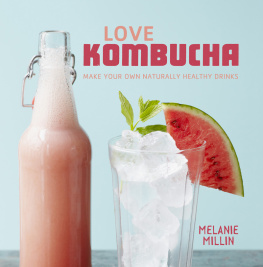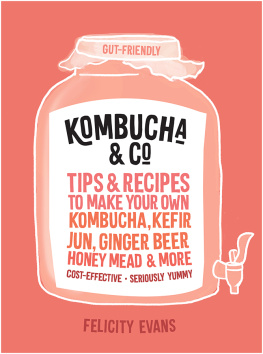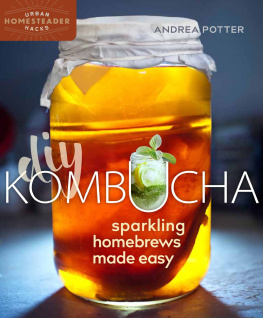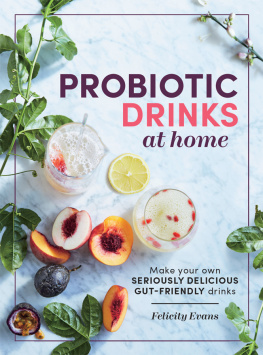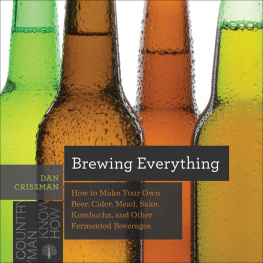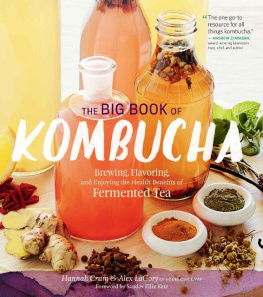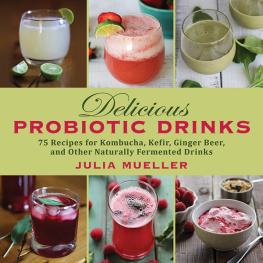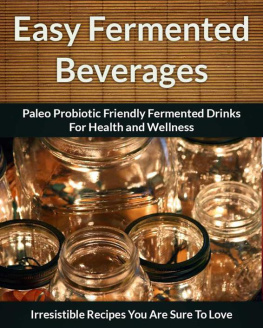


CONTENTS
INTRODUCTION
My name is Melanie Millin and I am the Founder and Chief Brewer at Love Kombucha, which I founded with my partner in 2013. So far its been an exciting and challenging journey. The more I learn about this fascinating drink, the more my thirst for knowledge grows. The capacity for new flavour combinations is almost endless and the longer I brew kombucha, the more obsessed by it I become.
Kombucha is an ancient drink made by fermenting tea and sugar with a live culture. As with other fermented foods, it is packed full of beneficial bacteria (that are great for digestion and gut health), amino acids and vitamins. It is naturally low in sugar and, whilst the brewing process can seem a little complex at first, it is really remarkably simple to make. You only need to spend about 20 minutes or so every couple of weeks to create your own wonderful flavours. If youre not sure about the level of commitment required, dont panic! Kombucha is very forgiving if you should forget about a batch or need to take a break to go on holiday.
Along the way (before going commercial) I probably made many of the mistakes that brewers the world over make, some of them harmless and others less so. I get regular emails from complete strangers looking for a culture to brew with or who have started brewing but dont really know how or why things need to be done a certain way. So what better way to share some of this knowledge than to put it all in a book?
There has been huge growth in the popularity of kombucha over the last five years; and this really is a worldwide trend. Kombucha is already immensely popular in North America where it has stepped out of both traditional and trendy health stores and into the mainstream and shows no signs of stopping. Australia boasts kombucha fans in their thousands and there are some fantastic established brands there as well as reputable sources of cultures for homebrewing. It has always been popular in Scandinavia, Russia and parts of Eastern Europe and now Western Europe is grappling to catch up now that they realise what they have been missing!
So kombucha is a thing thats not going away. Everyone I know thought I had finally lost the plot when I showed them this squishy, slimy gloop and told them it makes a fizzy drink that is good for you and I was going to leave my job to start a company. But I was (and still am) utterly convinced that everyone should have kombucha (or some form of naturally fermented food) as an addition to their diet. I was so in love with this little glass jar on my kitchen worktop and how it made me feel (well get onto that in a minute) that I genuinely just wanted to share it with everyone without too much thought of the practicalities of running a manufacturing company.
From that point forth, I bored every person I met with all things kombucha. There were two overwhelming and consistent responses. Firstly, few people had heard of it you might think that this would put me off, but strangely it had the opposite effect! If everyone knew of kombucha but chose not to buy or make it then I really would have been disheartened, but to me this seemed like the perfect opportunity to share the love I have for kombucha with a brand new and untapped audience. The second overwhelming response was genuine interest. I mean questions galore and encouragement that if it were commercially available, of good quality and at the right price, people would buy it.
Perhaps I was painting a particularly positive picture, based on my own good experience, but its really not just marketing spiel. Lets put it in perspective: theres this drink that is very low in sugar, lightly fizzy and good for you. It is naturally packed full of bacteria and yeasts that are beneficial to our bodies and contains nothing artificial (no laboratory concocted additions here!). It has a well-rounded, grown-up taste, not out of place in a wine glass or with dinner (how many soft drinks can say that?). Read that list again. And a third time just for good measure. Why would that NOT be a good idea?
So Love Kombucha was born. One glass brewing jar multiplied into two, which soon became a 25-litre brewing bucket. Quickly followed by two more, and three more and before we really knew it, Love Kombucha had a commercial warehouse with a microbrewery, a forklift truck and a license to operate it (still my most unexpected and favourite achievement to date!)
Slowly but surely, the kombucha word is spreading. I now have people writing to me to tell me that they are delighted they have discovered Love Kombucha, or that the blueberry flavour is their favourite. And to this day I am astonished that anyone has ever heard of us, let alone decided they have a favourite flavour! Nothing makes me happier than the anecdotes of real customers who tell us how it has helped them; from cutting down on fizzy drinks, or alcohol, to giving them a much needed boost during a period of illness, kombucha can be all sorts of things to all sorts of people.
It can be a functional, medicinal tonic that takes you a few minutes each week to make, or it can become a real hobby that you look forward to spending time on, creating something beneficial, completely from scratch. It can be as simple and quick as making a cup of tea or can become a much more elaborate process, as complicated as you want it to be.


HISTORY
Whilst Kombucha may be relatively new to you, it has, in fact been around for more than 2000 years and probably closer to 5000. There are many stories that claim to explain the heritage of kombucha, some of which are confused and others downright unlikely. However, the most widely believed is that the Chinese, in their quest for holistic health and long tea-steeped history, are the originators of kombucha. Written records date back to the Qin dynasty (220 BC) where it is referred to as the Tea of Immortality and often the Elixir of Life. Quite a claim! It is said that ancient emperors were sent off to war with a hipflask (or more likely an animal skin) of this bubbly fermented beverage to keep them strong and fit for battle.
Whatever the tall tales of the past, kombuchas relatively recent history can be more certain. By the 1900s, kombucha had made its way along the silk road from Asia and into Russia and parts of Eastern Europe where it became a staple in many homes. It was the kind of thing that would sit in a bowl or jar on the side in the kitchen at your grandmothers house and would be the first thing that she would reach for at the first sign of a sniffle. I have a Russian friend who is immediately transported back to her childhood whenever she smells the distinctive tang of a ripe kombucha ferment.
So what happened? Well, war happened, and tea and sugar became rationed in some parts of the world and hard to come by in others. As these are the two essential ingredients it is hardly surprising that this home production ceased to be a priority. Some households must have continued in order to keep the cultures alive and well (although you will find that they are much more hardy that you first expect) in order that they are still available today.
Next page
